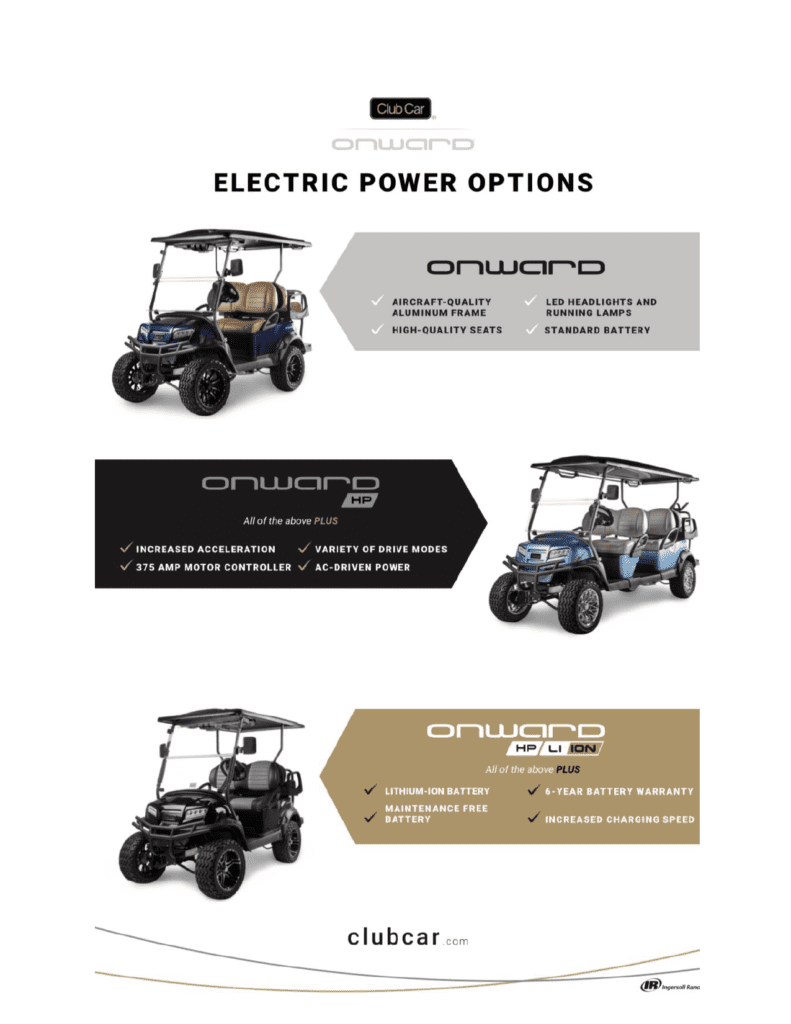You’ve decided a Club Car Onward is the right golf cart for you. With its practical components and stylish appeal, the Onward is a great choice to enjoy the outdoors with friends and family. But what goes into the customization options beyond selecting your Club Car’s make and model? There’s plenty to look at, from external choices and trim levels to what’s below the hood. Let’s take a look at your drivetrain, which transfers power to your wheels and keeps your Onward moving smoothly through your neighborhood.
The Onward comes with two drivetrain options: the High-Performance Flooded Lead Acid (HP FLA) and High-Performance Lithium-Ion (HP Ion) batteries. These two configurations have differing pros and cons, which we’ll walk through below.
What Does the High-Performance Drivetrain Do?
The Club Car Onward’s High-Performance Drivetrain offers remarkable versatility with a range of drive modes. Whether you need to drive uphill, on rough terrain in your backyard or just around the course, you’ll be able to safely and easily get to your destination. You can select regenerative braking, which efficiently feeds unused power back into your system, and opt for different acceleration modes such as econ, normal or sport. Each of these modes gives you the choice to prioritize battery power, a balanced mode or high performance.
As an additional nod toward efficiency, dynamic battery management is integrated with the power system, meaning the Onward conserves battery power by entering sleep mode at preset intervals.
Now that you know how the drivetrain impacts your overall ride, let’s move into the specifics of your drivetrain options.
What Are the Differences Between FLA and Ion?
Both High-Performance Flooded Lead Acid (HP FLA) and High-Performance Lithium-Ion (HP Ion) configurations share core components, including a 375 AMP motor controller, a 4.7 High-Performance AC motor and a vehicle control module. While there may be minor technical variations, your driving experience will be consistently smooth and enjoyable regardless of your choice.
That being said, the main difference between these two drivetrain setups is your choice of battery pack. The HP FLA uses Trojan T-875 batteries, which require regular checkups every 2-4 weeks to run properly. This is fairly simple, though, and we’re happy to show you what you’ll need to do to maintain battery health. More than likely, these checkups will involve you opening up the battery to make sure water completely covers the battery plates (that’s why they’re known as flooded batteries) and tooping up with distilled water if needed. Additionally, they are covered by the factory warranty for either two years for lifted models or three years for non-lifted models.
Specifications and Options for HP Ion Batteries
The HP Ion features sealed lithium-ion battery packs with zero maintenance needed throughout their lifespan.
The Onward’s HP Ion lithium-ion batteries come with a six-year warranty and a projected lifespan of 8-10 years. In addition to this perk, the HP Ion setup is incredibly light, reducing the Onward’s total weight. This means a slightly faster, more aerodynamic ride!
The Club Car Onward’s lithium-ion battery even has its own custom options: the standard pack and the extended range (XR) lithium-ion battery. The XR battery pack boasts twice the energy capacity as the standard battery pack, so you’ll be able to power your drivetrain for longer and with more “juice” than the standard option.
You can see the differences between each of these electric power options in our graphic below.

Create Your Ideal Onward with Us
If you want more details on potential customizations for your Onward or have questions, don’t hesitate to contact us! We’re here to help you make an informed decision on all available customizations for your Club Car Onward.
